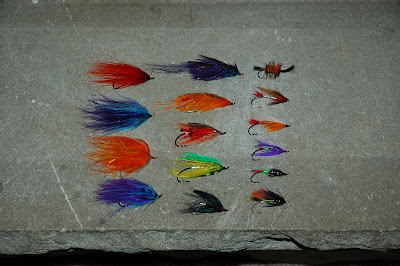The other day I was at a friend's bass pond, which is a very clear pond. The pond is loaded with big bass, some are really big, like over ten pound. Some of these fish are so big in fact, that one of the really big fish tried to eat a 15” bass as I was trying to land the smaller fish.
Anyway, as I was fishing this pond trying to get one of
these giant bass to eat my fly, I noticed how they would charge the fly from a
distance but then hesitate before taking to investigate the fly. The fish would
some time hit right away, but more often it would sit just below the fly and
either eventually take the fly or reject it. With the water being so clear, it
took a very realistic looking fly to fool the bigger fish. A frog painted
popper worked, while a yellow, green, and even minnow painted popper did not.
I think that this often happens while steelhead fishing as
well, though I don’t think it happens to the same degree as the current is
moving the fly through the water, and that means a steelhead is looking a moving fly and has to make a more momentary decision
on whether or not to take the fly. I believe that steelhead often see the fly
at a distance. They move into position to intercept the fly. Then they often investigate
the fly before taking or rejecting it.
 |
| Cummin's Special #5 |
I have seen this happen a few times, by watching from above
as another angler has a fish visibly following a fly. I have also often had
fish grab the fly as it changes its course in the swing (going from dropping
with the current to swing in toward shore), which leads me to believe that the
fish is often hovering near the fly and it reacts when the fly’s course
changes.
So how do we choose a fly that will attract a fish from a
distance and yet still be attractive enough to eat upon close inspection?
Over the last 15 years I have been trying to figure out the
answer to this equation. Of course every day of fishing can be different, fore
as a fishes environment changes so may its preferences in fly color, size, presentation,
etc.
For most of my time fishing steelhead I have had an approach
that assumed bigger was better. Figuring that because steelhead are eating
large food in the Ocean (or great lake) that they will prefer something large
to eat; Such as a 4” string leach, an intruder, or a spey fly tied on a 1.5-3/0
hook.
 |
| Yellow Jacket #5 |
Last year on my annuall trip out to fish the rivers of the Nez Perce, I had a day where i got a fish early on a #3 Yellow Jacket (a Dec Hogan pattern), a consisant fly with alot of black in it. once I got this fish I met up with my fishing partner and he was fishing the same fly, this makes sense as we have both caught a number of fish on this pattern in sizes #3 and #5. Well, since I had already landed a fish and would be following my friend down the run, I switched flies and decided to put on a #6-8 Purple Green Butt Skunk. Within a few casts I hooked into a large Steelhead. This really increased my confidence with this fly, so I kept it on for the rest of our time on the river. and it paid off with more hook ups over the next day and a half, even under bright mid-day sun.
 |
| Purple Green Butt Skunk #6 |
So using a big fly to get a fishes attention, may be effective for getting a fish to see the fly from a greater distance. But if you are fishing clear water the distance may be more than is needed and the fly may be intimidating to the fish once they are in close proximity. I think that if a fish can see the fly from a reasonable distance based on water and light conditions it is a good bet to use a small (#5-8) fly as the fish will have a smller object to interperate and a less intimidating object.
 |
| No Name #3 |
There are times when I think fish will respond better to bigger and/or brighter flies. so it is good to keep your box stock with a variety of patterns that cover the gammit. Have a few larger flies tied in muted colors, some big bright flies, and some small bright flies, to go along with your small subtle patterns.
I also think that adding detail to flies, that give them a more life like appearence up close helps in getting a fish to take. I add jungle cock as I think it looks like an eye. I also will use sparse grey spey hackle to creat the look of translucence.
 |
| no name #5 |







No comments:
Post a Comment